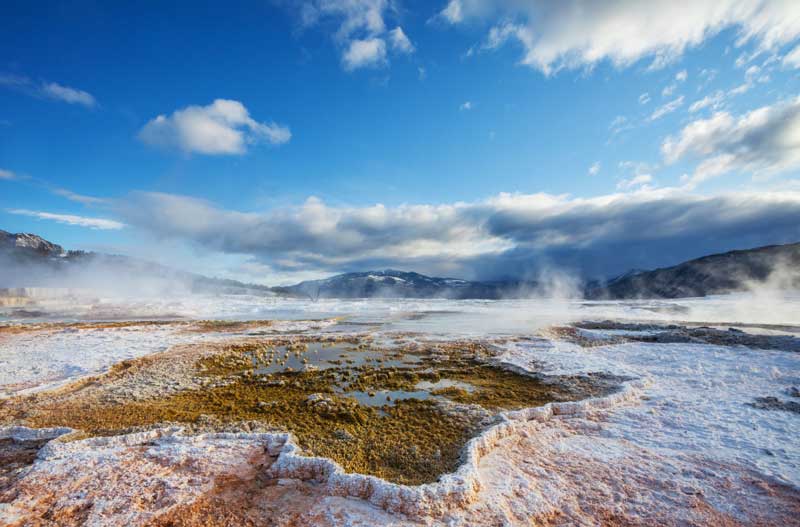Breathtaking vistas, geysers, and mountain trails await you in America’s national parks. From the Atlantic to the Pacific Oceans, beautiful natural areas are preserved for your enjoyment, but not all national parks have the same rules when it comes to your pets. While the national parks deliver magnificent natural beauty to enjoy with your furry four-legged family members you often cannot see the full scope of the park with them. Here is our list of five popular national parks that are not dog friendly, and their neighboring dog friendly federally protected alternatives.
Yellowstone National Park & Grand Teton
 Starting with the magnificent Yellowstone and Grand Teton National Parks, we’ve grouped these two areas together, as they are geographical neighbors.
Starting with the magnificent Yellowstone and Grand Teton National Parks, we’ve grouped these two areas together, as they are geographical neighbors.
Yellowstone is nestled within three states; Idaho, Wyoming and Montana. Established in 1872, Yellowstone is America’s first national park, and widely considered the first in the world! Known for its geothermal features and wildlife such as buffalo, wolves and elk, the park is a stunning sanctuary where nature thrives.
Grand Teton National Park is only 10 miles from Yellowstone Park. Grand Teton became a national park in 1929, preserving its natural wonders forever. Known for its 40 mile-long Teton Mountain Range, the highest peak will inspire you as it rises over 13,500 feet above the park!
While you can see some of Yellowstone’s stunning features from roadways or scenic stops, National Park Paws cautions that you will not be able to enjoy all of the park’s wonders with your pup. Grand Teton is similar, as dogs are only permitted along the roads. You will be able to take your pup to Jackson Lake, where dogs are permitted.
Luckily for park visitors, these areas are surrounded with National Forests. Why is this lucky? National forests are extremely dog-friendly, often offering off-leash areas, as long as your dog is capable of obeying voice commands.
To the east of Yellowstone is Shoshone National Forest. Created in 1891, it is the first federally protected national forest in America. To the west is Caribou-Targee National Forest, also created in 1891, and bordering both parks. To the north is Custer-Gallatin National Forest. Created in 1899 the forest comprises over 1.8 million acres. Lastly, is Bridger-Teton National Forest. This area spans 3.4 million acres and is the largest outside of Alaska!
All of these national forests are very dog-friendly, with options for hiking, camping and general exploration of the Yellowstone and Grand-Teton areas. For more details, visit the forest pet policies below:
- Bridger-Teton National Forest
- Caribou-Targee National Forest
- Custer-Gallatin National Forest
- Shoshone National Forest
Zion National Park
Located in southwestern Utah, Zion gained its national park status in November of 1919. Known for its red-colored sandstone and deep canyons, the park comprises 229 square miles of wilderness.
Offering deep canyons, red and orange Navajo sandstone and other geological wonders, Zion is also home to a vast variety of wildlife. 289 bird species, 32 reptile species, and 75 species of mammals – not to mention numerous plants, call Zion National Park home. The park offers magnificent natural arches, slot canyons, mountains and much more to delight your senses.
Zion National Park is generally not pet friendly, however dogs are allowed on the Pa’rus trail, paved roads and some campgrounds. If you want to explore the regions extraordinary natural and historical wonders, National Park Paws suggests these ideal options.
West of Zion National Park is Red Cliffs National Conservation Area. This area offers approximately 45,000 acres of rugged terrain with over 100 miles of non-motorized trails and heritage sites for you and your pup to explore.
To the north is Dixie National Forest, a two-million-acre area located in Utah. In preservation since 1905, the forest offers a wide variety of terrain and dog-friendly areas.
East of Red Cliffs is the ever stunning Grand Staircase-Escalante National Monument. This region is among the most remote in the country, featuring slow canyons, waterways and ancient Native American artifacts, there to discover as you explore the trails.
All of these areas are very dog-friendly options for hiking, camping and general exploration of the Zion National Park area. For more details, visit the pet policy pages below:
- Dixie National Forest
- Grand Staircase-Escalante National Monument
- Red Cliffs National Conservation Area
Redwood National Park
Redwood National Park is a combination of national and state parks. Comprising 139,000 acres of land, the park features breathtaking old-growth, temperate rainforests, amid stands of the stately redwood tree. Established in 1968 as a national park location, Redwood National Park is home to some of the tallest trees in the world, and one of the most massive tree species on the planet. The redwood forest was once over 2 million acres. Today, the park protects 45% of these special trees for future generations.
While dogs are allowed on some beaches, Redwood National Park is not considered to be dog-friendly. Prairie Creek State park, located to RSP’s immediate north, is also regarded as not dog-friendly. But don’t fret! You can still explore stunning neighboring areas with your four-legged friend.
Located to the north is Del Norte Coast Redwoods State Park, and while its not a federally protected area, it is still a dog-friendly location worth noting. Why? Because it offers superb trails that are home to miles of old-growth redwoods.
Another option is Six Rivers National Forest located to the east of RNP. Established in 1947, this forest offers over 1 million acres of dog-friendly fun. The forest has 366 miles of wild and scenic rivers, six distinct botanical areas, and public-use areas for camping, hiking, and fishing.
Lastly, Shasta-Trinity National Forest, located to the southeast of RNP, is an area of over 2.2 million acres ready to explore with your pup. Established in 1905, you will be spoiled with the choices of recreational activities available in this national forest.
All of these areas are very dog-friendly options for hiking, camping and general exploration of the Redwood National Park area. For more details, visit the pet policy pages below.
Great Smoky Mountain National Park
Not only a national park, Great Smoky Mountain is also a UNESCO world heritage site. Located in eastern Tennessee, this stunning park is home to the Great Smoky Mountains, as well as part of the Blue Ridge Mountains. Created in 1940 by FDR, it is the most visited national park in the United States. Encompassing over 500,000 acres, the park is home to 10,000 different species of plants and animals.
With so many visitors to these mountains, the Great Smoky Mountain National Park is, unfortunately, one of the least dog-friendly national parks in America. Dogs are allowed on two short walking paths within the park, otherwise, your four-legged pal is restricted to the paved roads.
Luckily, for dog-owning visitors, there are several dog-friendly neighboring areas to chose from. South of the park is Nantahala National Forest. Created in 1920, Nantahala is a Cherokee name meaning “Land of the Noonday Sun”. The largest of four national parks in North Carolina, it is a wonderful dog-friendly National Park alternative.
To the east is Pisgah National Forest, where over half-a-million acres have been in preservation since 1916. Pisgah is dog-friendly and promises not to let you and your furry family members down when it comes to accommodations and natural beauty.
To the North is Cherokee National Forest. One of our personal favorites, this national forest is ready to roam with 640 thousand acres of dog- friendly fun. It’s home to more than 20,000 species of plants and animals, all nestled in the heart of the gorgeous Appalachian mountain range.
All of these areas are very dog-friendly options for hiking, camping and general exploration of the Great Smoky Mountain National Park area. For more details visit the pet policy pages below:
Rocky Mountain National Park
Rocky Mountain National Park encompasses over 265 acres of federal land that has been in protection since 1915. In 1976 it became one of the first World Biosphere Reserves by UNESCO. The park is known for the stunning Rocky Mountain peaks and rugged terrain, conserved for your enjoyment. Nearly 70 mammal species and 300 species of birds call this park home, due to its varying topography and climates. Be prepared to experience the wildlife, as it is common to see elk grazing, a black bear strolling across the open vistas, or an eagle flying majestically overhead through the clouds.
Only 76 miles from Denver International Airport, this park is a hot spot for outdoor recreationists and weekend explorers. Despite Colorado being an otherwise dog-friendly state, dogs are not particularly welcome at Rocky Mountain National Park. Pets are not allowed on any hiking trails and are restricted to paved areas.
But not to worry. Wrapping around the national park to both the north and south, is the newly combined Arapaho-Roosevelt National Forest. In preservation since 1908, the combined area of the two forests consists of over 723 thousand dog-friendly, fun filled acres. Also located in the Rocky Mountains, you and your pup will have no problem finding extraordinary areas to explore.
A bit further west is Medicine Bow-Routt National Forest. Split by the continental divide, this forest is a 2.2-million-acre area located within Wyoming and Colorado. Preserved as park land since 1902, Arapaho-Roosevelt National Forests is very dog-friendly, with nearly no area off limits!
These surrounding forests will happily welcome you and your pup, with options for hiking, camping and general exploration of the Rocky Mountain National Park area. Summer is almost here, so get out with your four-legged friend and enjoy the beauty and splendor of America’s National Parks. For more details visit the pet policy pages below:
Do you agree with our list? Tell us your thoughts or park experiences in the comments below:








Leave a Comment
One Comment:
Thank you for this valuable information!!
We are planning to head out to explore the wonderful areas of USA and will be taking our dog. We were fretting about leaving him behind. Now we can all enjoy the sites!